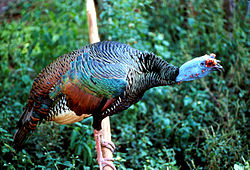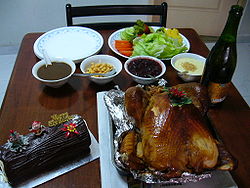Turkey (bird)
The turkey is a large bird in the genus Meleagris, native to North America. There are two extant turkey species: the wild turkey (Meleagris gallopavo) of eastern and central North America and the ocellated turkey (Meleagris ocellata) of the Yucatán Peninsula in Mexico. In the United States, people traditionally eat turkey on the holiday of Thanksgiving.
| Turkey Temporal range: Early Miocene – Recent
| |
|---|---|

| |
| Wild turkey | |
| Scientific classification | |
| Unrecognized taxon (fix): | Meleagridinae |
| Genus: | Meleagris Linnaeus, 1758 |
| Species | |
Naming
When people from Europe first saw turkeys in the Americas they thought the birds were a type of guinea fowl (Numida meleagris). This bird had been brought to central Europe from the country of Turkey. The name of that country stuck as the name of the bird.[1]
The confusion with the name is also seen in the scientific name: meleagris is Greek for guinea-fowl.
Turkey (bird) Media
A male ocellated turkey (Meleagris ocellata) with a blue head
Plate 1 of The Birds of America by John James Audubon, depicting a wild turkey
Depiction of ocellated turkeys in Maya codices according to the 1910 book, Animal figures in the Maya codices by Alfred Tozzer and Glover Morrill Allen
A turkey in a petting zoo in Japan
A roast turkey surrounded by a Christmas log cake, gravy, sparkling apple cider and vegetables
A male (tom) wild turkey (Meleagris gallopavo) strutting (spreading its feathers) in a field
References
- ↑ Messenger, Stephen (23 November 2010). "Naming of the Turkey". How an American Bird Got the Name 'Turkey'. The Guardian. Retrieved 23 September 2016.
Other websites
![]() Media related to Meleagris at Wikimedia Commons
Media related to Meleagris at Wikimedia Commons








